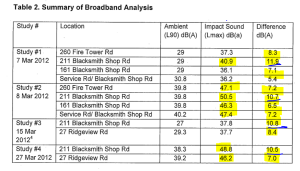Future Generation Wind Encroachment on Town of Bourne Air Space
By Chris Kapsambelis, BSEE
Introduction
The Future Generation Wind project to be sited close to the northern Bourne border will emit air contaminants, as defined by MassDEP regulation 310 CMR 7.00, that will result in a condition of air pollution over a large section of Bourne air space. The contaminants will be in the form of sonic and infrasonic radiation. In particular sound will exceed MassDEP regulation 310 CMR 7.10, the Town of Bourne WECS Bylaw, and the Minimum Performance Standards for Energy adopted by the Cape Cod Commission.
Evidence exists to show that these contaminants will impact residents at a distance of 3,000 feet or more from each turbine location. Some studies show that a safe setback distance should extend to a mile and a quarter. These emissions will trespass across the Bourne/Plymouth border resulting in widespread complaints that Bourne authorities will need to address.
Project Location
Public information, available from the Town of Plymouth, shows that four 2 MW wind turbines will be located as shown on the map below.

Wind turbine (FGW #1) is located 800 to 900 feet from the Bourne border, and 1,300 to 1,400 feet from the nearest residence on Morning Mist Lane.
Bourne Bylaw
The pertinent section of the Bourne bylaw is shown below:

The highlighted sections are the significant limits that Future Generation Wind is expected to exceed.
Data collected by MassDEP and others at distances comparable to the distance from the nearest Bourne residence (1,300 feet or more), show that the nighttime noise level will be in excess of 50 dBA, and the Modulation will be more than double the Bourne limit.
Below is a plot of data collected 1,800 feet from Falmouth’s wind turbine (Wind 1). It shows a maximum sound level in excess of 46 dbA, 6 dBA more than the Bourne nighttime limit of 40 dBA. It also shows Amplitude Modulation as high as 10 dBA, more than double the 4 dBA Bourne limit. There is no reason to believe that this sample represents the worst case scenario. Under different wind conditions the reading could be higher.
Since this sample reading was taken 1,800 feet from the wind turbine, doubling the distance to 3,600 feet will reduce the noise by 6 dBA, and close to the Bourne nighttime limit. Meeting the 4 dBA modulation limit will require even further increase in distance.
MassDEP
Falmouth
Widespread complaints, after Wind 1 at Falmouth’s Waste Water Facility went operational, led to MassDEP’s first wind turbine sound sample study.
Below is a summary of noise samples collected by MassDEP in Falmouth.
Fairhaven
After widespread complaints MassDEP conducted a noise study for two wind turbines installed in Fairhaven, MA where violations of the state noise regulations were discovered
The table below shows MassDEP samples from Fairhaven.
Kingston
Kingston, MA installed a 2MW wind turbine, called KWI, at about 1,000 feet from the nearest residence, which resulted in widespread complaints.
The table below is from the MassDEP aproved Kinston Study.
The highlighted column “Avg Lmax” is the metric MassDEP uses to measure the wind turbine sound level. In Kingston, where the wind turbine is 2 MW, matching the Future Generation Wind turbines in size and power, the whole column of sample readings, under the yellow highlight, is in excess the nighttime Bourne Bylaw limit of 40 dBA, and five readings are over 50 dBA.
The study also predicts, that based on the collected samples, conditions exist for the noise level to exceed MassDEP limits when turbine power generation is as low as 67 MW.
The only way to mitigate this condition is to turn the turbine off at night.
Cape Cod Commission
The Cape Cod Commission studied the question of wind turbine setbacks in great detail. They reviewed practices from around the world, received first hand comments from Falmouth residents impacted by Wind1, and testimony from citizens and public officials from state and local governments. In 2011 the Cape Cod Commission adopted amendments to their Minimum Performance Standards for Energy affecting the siting of wind turbines. A key provision to these amendments is the following:
MPS E1.8 – NoiseAll Applicants for a WECF greater than 660 KW shall perform a noise study and fund a Cape Cod Commission approved consultant’s review of the noise study, and adhere to a setback of 10 times the rotor diameter of the proposed turbine from the nearest receptor, or residentially zoned parcel,
Reports from the local Press:
Establishes for all turbines of 660 kilowatt (KW) capacity or greater a noise setback of 10 times the diameter of the turbine blades, as measured from the base to the nearest receptor — defined as any occupied residential or commercial property — or residentially zoned parcel;
For wind turbines the size used by Future Generation Wind, 10 times the diameter of the turning blades (rotor) amounts to about 3,000 feet.
Conclusion
The Future Generation Wind project will most likely produce widespread complaints, as did similar projects in Falmouth, Fairhaven, and Kingston. These complaints will compel authorities to investigate, and conduct studies that will find violations leading to orders for curtailment. Any curtailment of operations on these wind turbines will destroy the project profit margin.
It is in no one’s interest to proceed with this project. Nearby residents’ health and quality of life will be impacted, and Future Generation Wind is bound to suffer financial losses.



